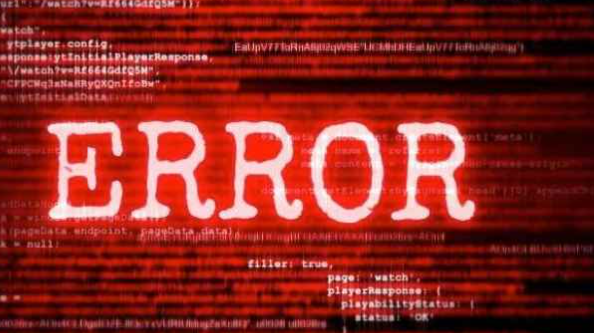
Introduction:
In the complex realm of programming, encountering errors is inevitable. One such enigmatic error that developers often come across is “errordomain=nscocoaerrordomain&errormessage=opgegeven opdracht niet gevonden.&errorcode=4”. In this article, we’ll delve into the intricacies of this error code, exploring its meaning, common occurrences, and potential solutions.
Understanding “errordomain=nscocoaerrordomain&errormessage=opgegeven opdracht niet gevonden.&errorcode=4”
When faced with the cryptic “errordomain=nscocoaerrordomain&errormessage=opgegeven opdracht niet gevonden.&errorcode=4”, it’s crucial to break down the components of the error code for a better understanding. The term “errordomain=nscocoaerrordomain” suggests that this error falls within the NSCocoaErrorDomain, a domain specifically related to Cocoa framework errors in Apple’s development environment.
Decoding the Error Message
The error message “opgegeven opdracht niet gevonden.” translates to “specified command not found” in English. This indicates that the error is triggered when a particular command or operation cannot be located or executed as intended. Developers often encounter this issue during the execution of tasks within their code.
Unraveling the Error Code 4
In the context of “errordomain=nscocoaerrordomain&errormessage&opgegeven opdracht niet gevonden.&errorcode=4”, Error Code 4 might indicate a failure or issue related to the command’s execution. It is imperative to inspect the surrounding code and context to identify the root cause of this error.
Common Scenarios Leading to “errordomain=nscocoaerrordomain&errormessage opgegeven opdracht niet gevonden.&errorcode=4”:
Developers may encounter this error in various scenarios, such as:
Command Line Execution: When attempting to execute a command via the command line, the specified operation may not be recognized, leading to the error.
File System Operations: This error can occur during file system operations when the code attempts to perform a task that involves a command not present or accessible.
External Dependencies: Integrating external dependencies or libraries that are not properly configured can trigger the error, especially if the required commands are missing.
Solving “errordomain=nscocoaerrordomain&errormessage=opgegeven opdracht niet gevonden.errorcode=4”:
Check Command Syntax: Review the syntax of the command triggering the error to ensure it is correctly formatted and recognized by the system.
Verify File and Path References: Double-check file and path references in the code to ensure that the specified commands and operations are valid and accessible.
Update Dependencies: Ensure that all external dependencies and libraries are up-to-date and properly configured within your project.
Consult Documentation: Refer to relevant documentation for the frameworks and libraries in use to identify any specific requirements or changes that might be causing the error.
Conclusion
In the world of programming, encountering errors is part of the journey. By understanding the nuances of “errordomain=nscocoaerrordomain&errormessage=opgegeven opdracht niet gevonden.&errorcode=4,” developers can navigate through the complexities, diagnose issues effectively, and implement solutions to keep their code running smoothly. Remember, meticulous attention to detail and a systematic approach are key when troubleshooting this enigmatic error.
FAQs
Q1: What does “errordomain=nscocoaerrordomain&errormessage=opgegeven opdracht niet gevonden.&errorcode=4” mean in simple terms?
A1: This error code indicates that a specified command, within the NSCocoaErrorDomain, cannot be found or executed as intended. The accompanying error message, “opgegeven opdracht niet gevonden,” translates to “specified command not found.”
Q2: When might developers encounter this error?
A2: Developers may encounter this error when executing commands via the command line, performing file system operations, or integrating external dependencies. It commonly occurs when a specific command cannot be located or executed during these tasks.
Q3: How can I troubleshoot “errordomain=nscocoaerrordomain&errormessage=opgegeven opdracht niet gevonden.&errorcode=4”?
A3: To troubleshoot this error, start by checking the syntax of the command, verifying file and path references, updating external dependencies, and consulting relevant documentation for the frameworks and libraries in use. Pay attention to details in the code and system configurations.
Q4: Is there a specific context where Error Code 4 might occur more frequently?
A4: While Error Code 4 can occur in various contexts, it might be more prevalent during command line executions, file system operations, or tasks involving external dependencies. Review the specific context in your code to identify the root cause.
Q5: Can updating dependencies resolve this error?
A5: Yes, updating external dependencies is a recommended troubleshooting step. Ensure that all dependencies and libraries are configured correctly within your project and are up-to-date. This can address compatibility issues that might trigger the error.
Q6: How crucial is it to consult documentation when facing this error?
A6: Consulting documentation is highly crucial. Documentation provides insights into the requirements, changes, and best practices associated with the frameworks and libraries in use. It can help identify specific solutions or adjustments needed to address the “errordomain=nscocoaerrordomain&errormessage=opgegeven opdracht niet gevonden.&errorcode=4” error.
